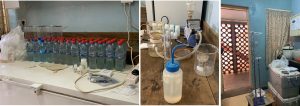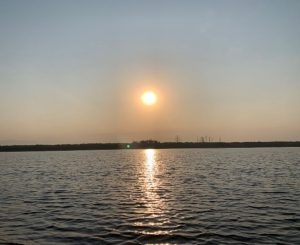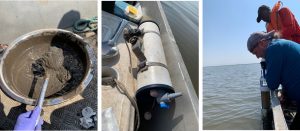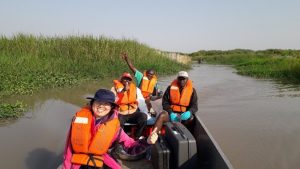May 22, 2023, by lzzre
Africa adventure: fieldwork for the impacts of aquaculture on Lake Victoria sustainability
Mingjie Sun, PhD Student
It has been over two years since I started my PhD in January 2021, when the world was still under the shadow of Covid 19. When my supervisor, Ginnie, told me that I had a chance to go to Africa with Dr Andy Marriot from the British Geological Survey (BGS), who has visited Lake Victoria many times before for boat surveys and catchment sample collection, I was extremely excited because it would be my first time visiting Kenya and my first adventure to Africa. This field trip was possible thanks to the strong collaboration between the Kenya Marine and Fisheries Research Institution (KMFRI) and the BGS. Thanks to their strong collaboration, KMFRI’s local knowledge and field experience, I learned a lot from both parties.
Our field site focused on the Winam Gulf, which borders the third largest city in Kenya, Kisumu, on the north-eastern of the shore. Every morning we set off from Dunga Beach with the beautiful sunrise, arriving when the local people had already returned from fishing.
The main purpose of the trip was to collect extensive contemporary samples, including water (river and lake) samples, surface sediment grabs and short sediment cores from sites along the coastal areas of Winam Gulf. Extensive sampling was also conducted upstream of the five main rivers feeding into the Gulf. These samples will provide crucial endmembers of stable isotopes of carbon to help better interpret the changes in carbon source and productivity in my lake sediment cores over time (e.g. more or less erosion and/or more eutrophication). My study will complement the research objectives that Andy and the BGS team also have.
In order to access the multiple sites across the shore of the Gulf, we powered our boat through swathes of water hyacinth. Sediments, water and cores were collected from the boat. As my project is also interested in agal pigment biomarkers, I would filter the water collected from rivers and the gulf to investigate the ecology of the Gulf and its dominant inflows.
Andy and I were given access to KMFRI laboratories to process the sediment cores, extruding them into thin 1cm slices for transport to the UK. We also subsampled the sediment grab samples and filtered the water samples filtration with the help of George and his colleagues at KMFRI. I have learned so much during this expedition, including how to choose sites, collect samples, extrude cores, filter water, write detailed field notes, and work on a boat.
My trip was part-funded by the School of Geography Postgraduate Research Fund, which I would like to acknowledge along with the help of Sue Davis and Teresa Needham I would also like to thank Dr Marriot for making all the necessary travel arrangements, teaching, guiding me in the fieldwork, and letting me learn so much about field and research activities. Thanks to George and his colleagues at KMFRI, they are very experienced field researchers and provided me with enthusiastic help and kind assistance during the research trip to Winam Gulf. They also helped me a lot with local life. This trip is one of my best adventures and my most unforgettable memory.

Water samples from gulf and input rivers, reusable filter units, and core sediment subdivide devices
No comments yet, fill out a comment to be the first




Leave a Reply